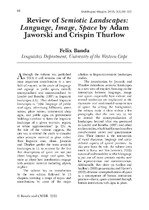| dc.contributor.author | Banda, Felix | |
| dc.date.accessioned | 2020-11-06T11:35:43Z | |
| dc.date.available | 2020-11-06T11:35:43Z | |
| dc.date.issued | 2015 | |
| dc.identifier.citation | Banda,F. CMDR.2015, 2(1):96-100 . Review of Semiotic Landscapes: Language, Image, Spaceby Adam Jaworski and Crispin Thurlow | en_US |
| dc.identifier.uri | https://doi.org/10.14426/mm.v2i1.61 | |
| dc.identifier.uri | http://hdl.handle.net/10566/5379 | |
| dc.description.abstract | Although the volume was published
in 2010, it still remains one of the
most important contributions to a new
field of enquiry in the study of language
and signage in public spaces initially
conceptualised and institutionalised by
Landry and Bourhis (1997) as linguistic
landscapes (LL). They defined linguistic
landscapes as “[t]he language of public
road signs, advertising billboards, street
names, place names, commercial shop
signs, and public signs on government
buildings combine to form the linguistic
landscape of a given territory, region,
or urban agglomeration” (p. 25). As
the title of the volume suggests, the
aim was to extend the study to consider
other semiotic material in place rather
than linguistic ones alone. Jaworski
and Thurlow prefer the term semiotic
landscapes to LL to account for the fact
that descriptions of space are not just
about language, image and space, but
more so about how interlocutors engage
with semiotic material including objects
in plan. | en_US |
| dc.language.iso | en | en_US |
| dc.publisher | CMDR | en_US |
| dc.subject | Linguistic landscapes | en_US |
| dc.subject | Semiotic | en_US |
| dc.subject | Discursive | en_US |
| dc.subject | Multimodal | en_US |
| dc.title | Review of Semiotic Landscapes: Language, Image, Spaceby Adam Jaworski and Crispin Thurlow | en_US |
| dc.type | Article | en_US |

